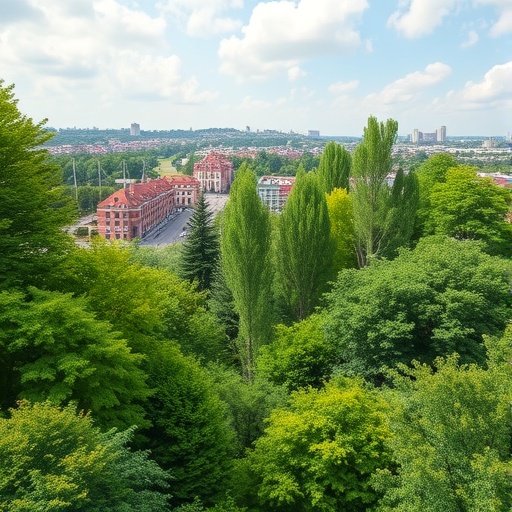In the realm of atmospheric science and environmental modeling, accurately quantifying biogenic volatile organic compound (BVOC) emissions has remained a formidable challenge, especially in landscapes profoundly altered by human activity. Recent research led by Zhang, Ran, and Guenther, published in Nature Communications, marks a significant advancement in this field by refining the modeling of BVOC emissions in regions where natural ecosystems intersect with urban and disturbed forest edges. This breakthrough holds substantial implications for understanding atmospheric chemistry, air quality, and climate dynamics in human-dominated environments.
Biogenic emissions, primarily consisting of volatile organic compounds released by vegetation, play a crucial role in the atmospheric processes that govern the formation of ozone and secondary organic aerosols. Traditionally, modeling these emissions has relied extensively on standardized approaches assuming relatively uniform natural conditions. However, as urban sprawl and forest disturbances alter microclimatic and ecological factors, conventional models struggle to capture the true variability and intensity of BVOC fluxes at these transition zones.
The study presented by Zhang and colleagues introduces an advanced modeling framework that integrates detailed ecological and environmental variables specific to forest edges disturbed by human activities and adjoining urban landscapes. By incorporating spatially resolved land use data, meteorological parameters, and vegetation physiology, this model effectively bridges the gap between natural forest emissions and those impacted by anthropogenic disturbances. This synergistic approach addresses the complexity of emission patterns in heterogeneous environments.
One of the groundbreaking aspects of this research is the explicit emphasis on edge effects, a well-documented yet often underrepresented phenomenon in biogenic emission models. Forest edges, where canopy structure, light availability, and temperature gradients shift abruptly, experience modifications in plant stress and photosynthetic activity — factors known to influence BVOC emissions substantially. The refined model captures these gradients with a level of precision unattainable in previous frameworks, highlighting their critical importance.
Urban areas, frequently considered as sinks or minor emitters in earlier biogenic models, are reexamined under this new paradigm. The study reveals that vegetation within cities, such as street trees and urban parks, exhibits distinct emission characteristics influenced by stressors including pollution, fragmented habitats, and heat island effects. The model’s capacity to assimilate these nuanced emission sources unravels previously underestimated contributions to local and regional atmospheric chemistry.
By employing an extensive dataset comprising field measurements, remote sensing inputs, and laboratory calibrations, the researchers validated the model against observed emission fluxes across multiple disturbed forest edge sites and urban settings. Results demonstrate a marked improvement in matching real-world data, reducing uncertainties that have long confounded predictive air quality models. This enhanced accuracy is poised to inform more effective environmental policies and urban planning endeavors.
The implications of improved BVOC emission modeling are multifold. Enhanced representation of these emissions informs better forecasts of ozone formation, a pollutant detrimental to human health and vegetation, especially in urban and peri-urban regions. Moreover, understanding how anthropogenic disturbances modify natural emission patterns aids in anticipating feedback mechanisms under climate change scenarios, where shifts in land use and vegetation distribution are expected to intensify.
Furthermore, the study sheds light on the critical role of biogenic emissions in forming secondary organic aerosols (SOAs), particulate matter that affects climate forcing and air quality. Accurately quantifying SOA precursors in mixed urban-natural landscapes enables atmospheric chemists to predict aerosol concentrations and properties more reliably, a task essential for climate modeling and public health assessments.
An intriguing dimension of this research lies in its methodological innovation. By integrating mechanistic plant physiology models with spatially explicit urban disturbance data, the framework transcends purely empirical approximations. This computational synergy allows for dynamic simulation of emission responses to fluctuating environmental variables, such as temperature spikes and drought stress, scenarios prevalent in disturbed ecosystems.
The authors also emphasize the potential application of their model in urban forestry management and design. By understanding BVOC emission patterns, urban planners can strategically select and position vegetation species to minimize adverse air quality impacts while maximizing ecosystem service benefits like shade and carbon sequestration. This aligns with the growing movement toward sustainable urban environments resilient to environmental stressors.
Moreover, the research supports the trend toward leveraging remote sensing technology for environmental modeling. High-resolution satellite imagery and airborne sensing data provide vital inputs on vegetation health, canopy cover, and urban morphology, which, when coupled with the model, enhance near-real-time emission assessments. These developments promise to advance dynamic monitoring of biogenic emissions across rapidly changing landscapes.
While the model presents substantial progress, the authors acknowledge the need for continued refinement. Complex interactions among multiple environmental stressors, species-specific emission responses, and seasonal phenology require further empirical datasets to deepen model robustness. Additionally, expanding model applications to diverse biomes and urban configurations worldwide will test its generalizability and foster adaptive environmental management strategies.
Critically, this work underscores the intertwined nature of human activity and natural processes. Ecosystems on the edge of urbanization act as biochemical melting pots, where altered emission regimes can cascade through atmospheric reactions, influencing both local air quality and global climate patterns. Integrative models like this one illuminate pathways to mitigate negative outcomes of anthropogenic disturbance.
In conclusion, Zhang and colleagues have delivered a compelling advancement in atmospheric science by developing an improved modeling approach that accurately captures biogenic emissions at human-disturbed forest edges and urban interfaces. This work not only refines our understanding of complex emission dynamics but also equips policymakers and scientists with a robust tool for navigating the environmental challenges of the modern, urbanizing world. The ripple effects of this research could resonate through air quality management, climate mitigation efforts, and urban ecological design for years to come.
Subject of Research: Modeling of biogenic volatile organic compound (BVOC) emissions in human-disturbed forest edges and urban areas.
Article Title: Improved modelling of biogenic emissions in human-disturbed forest edges and urban areas.
Article References:
Zhang, Y., Ran, H., Guenther, A. et al. Improved modelling of biogenic emissions in human-disturbed forest edges and urban areas. Nat Commun 16, 8064 (2025). https://doi.org/10.1038/s41467-025-63437-8
Image Credits: AI Generated




